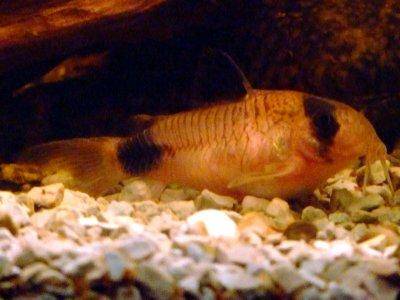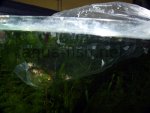The Ultimate Guide to Corydoras Catfish: Origin, Breeding, Diet, and Care
Quick links
Brief Description
This page provides an introduction to raising the Corydoras species and highlights some of the most popular varieties. We'd love to hear about your experiences with Corydoras at the bottom of this page. Feel free to visit our search page within our database, where you'll find detailed care information on various Corydoras species for home aquariums.
Short Introduction
Corydoras, commonly known as Cory catfish, Cory cats, or simply Cories, are small fish originating from South America. They thrive in freshwater environments. The name Corydoras comes from Greek, combining “kory,” meaning helmet, and “doras,” meaning skin. There are many varieties of these fish, distinguished by their colors and sizes. Most Cory species grow to about 4 to 6 cm (1.57 to 2.36 inches) in length. This article provides an overview of what they have in common, with links to specific species at the end.
Recommended Tank Setup for Corydoras – Ideal Parameters
Corydoras thrive best in aquariums with a sandy substrate, as their sensitive barbels are easily damaged by rough surfaces. Fine gravel with a diameter of around 3 mm (0.1 inch) can also work well. A dark substrate is recommended, as these fish are sensitive to stress and prefer to seek shelter in dim environments. The dark color helps them feel more secure, reflecting their natural habitats where they are not predators.
It’s important to monitor your tank setup to prevent Corys from getting stuck in decorations or plants with strong roots or rhizomes, such as Anubias. If they get trapped and aren't rescued quickly, their barbels could be injured, though they usually grow back within 4-8 weeks. Regularly counting your Corydoras is essential, especially for smaller ones that might get caught in roots or rockwork, as they might not find their way out, leading to breathing difficulties and potential fatalities.


Most Corys thrive in a tank with moderate heating, ideally around 25°C (77°F). The general water hardness should be between 4°N dGH (71.43 ppm, 1.43 mEq) and 18°N dGH (321.43 ppm, 6.43 mEq), although a range of 8-12°N dGH (142.86 - 214.29 ppm, 2.86 - 4.29 mEq) is often ideal. A neutral pH of 7 is recommended for Corydoras tanks.
When properly cared for, these fish can live exceptionally long lives. For example, a Corydoras aeneus once lived for 27 years in captivity, and it's not uncommon for them to reach 20 years.
Water Quality is Crucial
Corys are highly sensitive to even moderate levels of ammonia and nitrites, which can be harmful to their health. If you're raising livebearers like Guppies, Mollies, or Platies in a small tank without excellent filtration, Corys may not be the best choice for your setup. It's essential to monitor the water quality weekly, as these fish thrive in clean conditions. The ideal readings for ammonia, nitrates, and nitrites are zero, ensuring a safe environment for your Corys.
Sensitivity – Transport and Sudden Changes in Water Chemistry
Corys are not just sensitive to poor lighting conditions or ammonia; they also require stable water chemistry more than many other species. Even if your tank is well-suited for Corydoras, newly introduced specimens might still struggle and potentially die within weeks due to the significant differences between their previous and new environments. Changes in pH, hardness, and temperature should be made gradually to avoid stressing the fish. For pH, a gradual change of 0.1 per week is recommended, while hardness should be adjusted by no more than 1°N dGH (17.86 ppm, 0.36 mEq) per week. Temperature changes can be managed more quickly, with several degrees per day being generally safe, as temperature naturally fluctuates between day and night.
If you are preparing to transport Corys, it's crucial to test the water in their current tank and replicate those conditions in their new home as closely as possible. Ensure that pH, carbonate hardness, general water hardness, and temperature are similar before starting the acclimatization process. If there's an ammonia spike in their current tank, do not attempt to replicate elevated levels of ammonia or nitrites. Properly matching these conditions will help minimize stress and increase the chances of a successful transition.
The process of introducing fish to their new home follows a simple and effective routine:
- Before introducing your fish, turn off the aquarium lights to reduce stress.
- Place the plastic bag containing the fish on the water's surface to allow the temperature to equalize. You can cut a small hole in the bag to allow fresh air to circulate inside.
- Feed your existing fish (excluding the Corydoras) to prevent them from mistaking their new tankmates for food.
- After 15-20 minutes, gently release your new Corys into the aquarium.
Remember that all Corys are social fish and should be kept in groups of at least six, though a group of 15-20 is ideal. Each Cory needs approximately 25 square centimeters (3.87 square inches) of space. For example, a group of 10 Corys would require 250 square centimeters (38.75 square inches) of surface area, which is about 25x10 cm (9.84x3.93 inches). These fish will mostly inhabit the bottom of the tank.
Ideal Diet for Corys
Although many aquarists believe that flakes are sufficient, Corydoras require more than just flakes. Flakes typically don’t sink quickly, so fish that swim in the upper or middle levels of the tank usually eat them before they reach the bottom. Additionally, Corys have downward-pointing mouths, designed for gathering food from the substrate, plants, or rocks.
Corydoras are omnivores, and their ideal diet includes:
- Sinking wafers
- Mosquito larvae and small worms
- Daphnia
- Brine shrimp
- Pellets (such as cichlid pellets)
- Chips (like Sera Wels-Chips)

Ideal Tank Mates
Perfect tank mates for Corydoras include peaceful species like Angelfish, Discus, and Ram cichlids, as well as other calm fish that originate from South America. Even some peaceful Asian loaches and other compatible fish can coexist with Corys. However, it’s important to avoid territorial tank mates such as the Pictus catfish, aggressive cichlids, or Puffers. These species often come from different regions and may have different water requirements. A particularly poor combination is keeping African cichlids, which need hard, alkaline water, with Corydoras, which prefer neutral water and can thrive in slightly higher temperatures. Below is a list of suitable tank mates:
- Adonis pleco - Acanthicus Adonis
- Yellow acara - Aequidens metae
- Marbled raphael catfish - Amblydoras hancockii
- Bristlenose catfish - Ancistrus cirrhosus
- Gold marble bristlenose catfish - Ancistrus claro
- Bushynose pleco - Ancistrus temminckii
- Bloodfin tetra - Aphyocharax anisitsi
- Green fire tetra - Aphyocharax rathbuni
- Blue cheek dwarf cichlid - Apistogramma eunotus
- Redstripe dwarf cichlid - Apistogramma hongsloi
- Altum angelfish - Pterophyllum altum
- Angelfish - Pterophyllum scalare
- Discus - Symphysodon aequifasciata alenquer
However, certain species should never be kept with Corydoras:
- Green terror cichlid - Aequidens rivulatus
- Red striped earth eater - Geophagus surinamensis
- Severum - Heros efasciatus
- Black banded leporinus - Leporinus fasciatus
- Red bellied piranha - Pygocentrus nattereri
If Corydoras feel threatened by a predator, they can raise a spine on their dorsal fin, which can lodge in the predator’s throat, potentially leading to the predator's death. This is why choosing suitable tank mates is crucial for their well-being.
Sexing Corydoras
Males are generally smaller and less rounded than females. Additionally, males often chase females, especially during the breeding season, when it is not uncommon to see two or three males pursuing one female. This behavior can be stressful for the female if it continues for too long, potentially leading to premature death. To prevent this, the ideal male-to-female ratio should be 1:1 or, preferably, 1:2.
Breeding Corydoras
Breeding Corydoras can be somewhat challenging, especially for beginners. However, Corydoras are known to sporadically lay eggs even without the keeper's intention. These fish typically lay between 10-15 eggs in one spot, usually on the glass, but they can also choose leaves or decorations as egg-laying sites. Because of the small number of eggs, they can be difficult to spot and are often eaten by other fish.
The breeding process can be encouraged by lowering the tank temperature to 21°C-22°C (69°F-71°F) and offering live or frozen foods such as worms, small insects, insect eggs, or larvae. All these foods can be either frozen or live, but frozen food must be thawed before being given to the fish! Frequent water changes can also stimulate breeding, and sometimes separating the male from the female can help, though it's not the most effective trigger. The pH in a breeding tank should be between 7 and 7.2.
If eggs are laid, it’s advisable to carefully remove them with a credit card or razor blade and place them in a separate tank. This can be tricky as the water parameters in the new tank must match those in the original tank. Since this approach isn’t always feasible, breeding Corydoras in a dedicated tank is another option. The worst scenario for breeding is to leave them in a community tank, where the chances of the eggs hatching are the lowest.
Newborn Corydoras should be fed with newly hatched Artemia salina or microworms, which can be purchased at local pet stores. These newborns often consume algae, which is beneficial as it increases their survival rate by reducing their dependency on food provided by the keeper.
List of species
Here is the list of various Corydoras species:
- Corydoras adolfoi (Adolfo's cory)
- Corydoras aeneus (Bronze cory)
- Corydoras agassizii (Agassizii's cory)
- Corydoras ambiacus (Spotted cory)
- Corydoras arcuatus (Skunk cory)
- Corydoras atropersonatus (Fairy cory)
- Corydoras axelrodi (Pink corydoras)
- Corydoras bilineatus (San juan cory)
- Corydoras bondi (Bond's catfish)
- Corydoras concolor (Concolor cory)
- Corydoras davidsandsi (Sand‘s Corydoras)
There are many more species available. To explore our comprehensive database, click here to access the search page.
Video
Watch a video featuring Panda Corydoras here: Download video (approximately 21 MB, 1 minute 37 seconds, MPEG-1 format).






